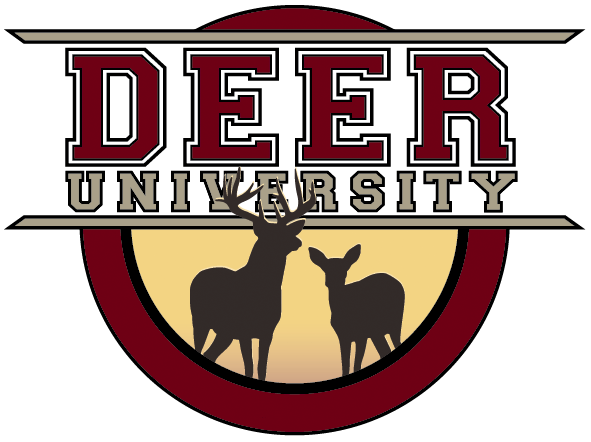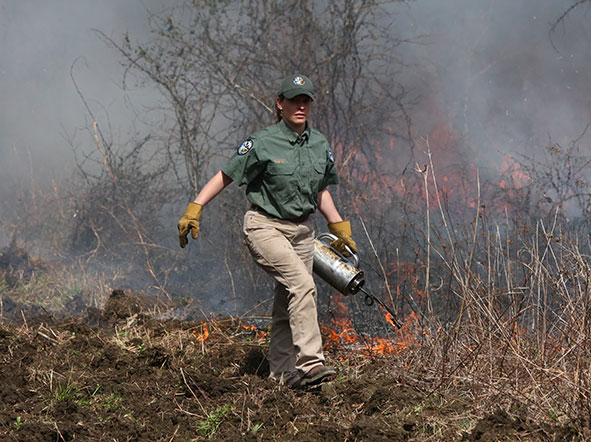Biology of the Rut
Wildlife in temperate regions, where there are distinct seasons, must prepare themselves physiologically and anatomically for major weather extremes and changes in life history. Bucks switch from growing antlers and fattening their bodies during the heat of summer to a self-imposed change in diet and activity level in the fall that would make trainers on The Biggest Loser envious. Females switch from losing body weight while raising fawns to a quick fattening process and then a short 1-2 day period of individual breeding behavior. To be successful in the wild, these major shifts in physiology and anatomy must be anticipated and prepared for so the animals are ready when circumstances arrive, sort of like the preparation a family does in advance of an annual vacation. A deer's calendar of events has two levels of timing — for bucks, it's a seasonal time frame (think, "autumn") and for does, it's a shorter time frame (think, "Thanksgiving holiday").
A deer's seasonal calendar of physiological events (like changing from their summer coat to winter coat) is calibrated by the amount of daylight and dark. More hours of darkness increases melatonin production, a hormone produced by the pineal gland at the base of the brain. Increased melatonin starts a series of physiological processes that activates (or deactivates) the various physiological processes needed for the upcoming seasonal changes.
Reproduction is the seasonal process that generates so much interest during the hunting season. White-tailed deer are "short-day breeders," meaning they breed during autumn when day length is declining and nighttime is increasing.
Once the "breeding season" arrives, the physiological processes differ between bucks and does. A buck is capable of breeding anytime between velvet shed in early autumn to antler drop in late winter (again, think autumn). A buck's breeding season is determined by having sufficient levels of testosterone in the bloodstream, which also regulates the buck's antler cycle. Thus, when a buck has hard antler he is capable of breeding. So, a buck is a willing breeder for 4-5 months, waiting only until he finds a female in estrus. A doe is much different, she will breed only when her particular hormones make her ready (again, think Thanksgiving holiday).
A female's reproductive period is tied to a group of hormones regulated by a part of the brain (hypothalamus), the pituitary gland, and her ovaries. She will not ovulate or exhibit any of the behaviors associated with estrus (or "heat") until her body contains the correct concentrations of luteinizing hormone, estrogen and progesterone. This unique set of hormone concentrations happens on a short time frame of 2-3 days. These hormones also stimulate her to secrete the scents that are so attractive to a buck and will cause every buck in the area to act much more carelessly than usual. Production of these hormones are on a roughly 28-day cycle, just like women, and nothing other than the correct hormone concentrations will allow her to enter into estrus.
During what is called the "pre-rut" period there are few does in estrus in the population, but those few does in estrus will change buck behavior. Once bucks detect some does are in heat, the searching and chasing phase begins. Bucks are either courting those few does that are in heat or they are searching the woods for does that are nearing estrus. Most hunters see many more bucks in the pre-rut than they do during the peak rut. Again, this is because bucks are roaming the woods searching for the relatively few does that are physiologically capable of breeding. Once the peak of the rut arrives a week or two later, hunters will typically see fewer bucks because they are courting and breeding receptive does, rather than searching for receptive does.
Changing weather can stimulate deer movement, but a drop in temperature does not influence when the breeding season occurs. Again, the breeding season is determined by hormone concentrations that are calibrated by the annual photoperiod cycle. Biologists know the breeding season of a deer population is remarkably similar from year to year because they can examine and age the fetuses of does that are harvested late in the hunting season. By aging (how many days old) fetuses, a biologist can determine when a doe was bred. With enough data, a deer biologist can accurately determine when the occurred. For decades, deer biologists have examined and aged fetuses from populations and shown the breeding season occurs at approximated the same few weeks each year. So just because you don't see as much rut activity in a given year doesn't mean the rut didn't happen.
For explanations of why the rut differs from place to place, or how the timing of the rut can change over time in a deer population please see Ecology of The Rut Section.



